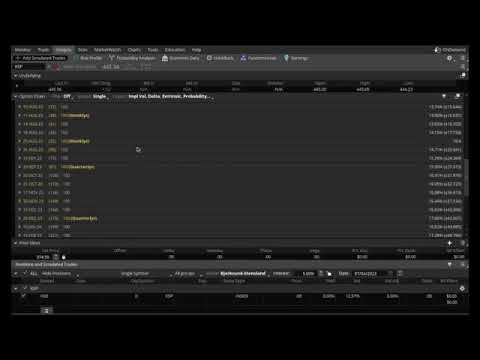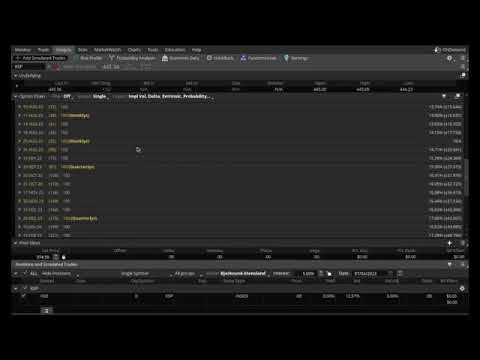Alright, let’s dive into the topic of constructing the put ratio spread and put broken wing butterfly options strategies. In this video, the speaker shares their experience of initially wanting to use the “emrod” but finding it to be a bit erratic. However, they recommend using the XSP index option instead. The speaker takes us through the process of finding the optimal expiration date and explains that monthly options tend to be more liquid. They then delve into the step-by-step process of constructing the put ratio spread by identifying the delta and adjusting the strikes to achieve a desired credit amount. Additionally, they analyze the credit and potential profit for different strike adjustments. The video also covers constructing the put broken wing butterfly by setting up the put ratio spread first and then adding a long put option for risk management. They explain how to adjust the strikes and identify the maximum risk and break-even points. Don’t forget, the video suggests adjusting the spreads of the put ratio spread before adjusting the butterfly. So, get ready to learn all about constructing the put ratio spread and put broken wing butterfly strategies in this informative video!
1. Introduction
In this article, we will discuss the construction of two options trading strategies: the put ratio spread and the put broken wing butterfly. These strategies allow traders to take advantage of market conditions and maximize potential profits. We will provide an overview of each strategy and guide you through the process of selecting the right options, constructing the spreads, and adjusting them if necessary.
2. Overview of Put Ratio Spread
2.1 Explanation of Put Ratio Spread
The put ratio spread is an options strategy that involves selling a higher number of out-of-the-money put options while simultaneously buying a lower number of in-the-money put options. This strategy allows traders to generate income and limit potential losses by using a combination of short and long put positions.
2.2 Benefits of Put Ratio Spread
The put ratio spread provides several benefits for traders. It allows them to take advantage of market volatility and generate income from the premiums received from selling the options. Additionally, this strategy limits the potential loss by having a long put option to offset the short put option. This way, the trader can benefit from a moderate move in the underlying asset while still maintaining a limited risk profile.
3. Choosing the Right Option
3.1 Comparison between ’emrod’ and XSP Index Option
Initially, the speaker wanted to use the “emrod” for the put ratio spread but found its spread to be erratic. Instead, the speaker recommends using the XSP index option, particularly the Mini SP500 Index. The XSP option offers better liquidity and a more stable spread, making it a suitable choice for constructing the put ratio spread.
3.2 Selection of Expiration Date (DTE)
When selecting the expiration date, it is essential to find the optimal Days to Expiration (DTE). The speaker suggests looking for options with expiration dates within the range of 45 to 65 days. Within this range, the speaker advises choosing the monthly options as they tend to be more liquid compared to weekly options.
3.3 Liquidity of Monthly Options
The liquidity of options is crucial when constructing a put ratio spread. Monthly options are generally more liquid than weekly options. This higher liquidity ensures that traders can easily enter and exit positions without significant slippage. It is recommended to prioritize monthly options when constructing the put ratio spread.

4. Constructing the Put Ratio Spread
4.1 Identifying Delta
To construct the put ratio spread, it is essential to identify the delta for the short strike. The delta represents the sensitivity of the option price to changes in the underlying asset price. For the short strike, the speaker suggests selecting options with a delta between 16 and 20.
4.2 Adjusting Strikes for Desired Credit Amount
After identifying the short strike, the trader needs to adjust the strikes to achieve the desired credit amount. The credit represents the premium received from selling the put options. By adjusting the long strike, the trader can manipulate the credit amount and potentially maximize profits.
4.3 Analyzing Credit and Potential Profit for Different Strike Adjustments
Traders should analyze the credit and potential profit for different strike adjustments to find the optimal configuration. By adjusting the strikes, traders can expand or narrow the profit zone and potentially increase the probability of profit. It is important to consider the trade-offs between credit amount upfront and potential profits or a wider profit zone.
5. Overview of Put Broken Wing Butterfly
5.1 Explanation of Put Broken Wing Butterfly
The put broken wing butterfly is an advanced options strategy that combines a put ratio spread with the addition of a long put option for risk management. This strategy allows traders to create an asymmetrical profit zone that favors a specific direction while still maintaining a limited risk profile.
5.2 Incorporating Put Ratio Spread into Butterfly Strategy
The put ratio spread is incorporated into the butterfly strategy by using it as the core spread. The long put option is added to modify the risk profile and create a broken wing effect. This modification allows traders to have a higher potential profit in one direction while still limiting losses in the other.
6. Constructing the Put Broken Wing Butterfly
6.1 Setting up the Put Ratio Spread
To construct the put broken wing butterfly, the trader first needs to set up the put ratio spread according to the previously discussed guidelines. By selecting the appropriate options and adjusting the strikes, the trader creates a put ratio spread with their desired risk and profit parameters.
6.2 Adding a Long Put Option for Risk Management
After establishing the put ratio spread, a long put option is added to the strategy for risk management. This additional option helps limit potential losses in case the market moves in an unfavorable direction. The long put provides a buffer against downside risk while still allowing the trader to benefit from favorable price movements.
6.3 Adjusting Strikes and Identifying Maximum Risk and Break-Even Points
Traders need to adjust the strikes of the put broken wing butterfly to achieve the desired risk and profit profile. By manipulating the strikes, the trader can identify the maximum risk and break-even points for the strategy. This information is crucial for understanding the potential outcomes and managing the position effectively.
7. Adjusting the Put Ratio Spread
7.1 Importance of Adjusting Spreads First
When adjusting options positions, it is important to prioritize adjusting the put ratio spread first. The put ratio spread is the core of the strategy and should be managed and adjusted based on changes in market conditions. By adjusting the put ratio spread, traders can adapt to evolving market dynamics and maintain a balanced position.
7.2 Strategies for Adjusting the Spread
There are several strategies for adjusting the put ratio spread. These can include rolling the spreads to a different strike, adjusting the number of contracts, or closing out the position altogether. The choice of adjustment strategy depends on the trader’s outlook on the market and their risk management goals.
8. Adjusting the Put Broken Wing Butterfly
8.1 Strategies for Adjusting the Butterfly
Similarly to the put ratio spread, the put broken wing butterfly may require adjustments based on market conditions. Traders can employ various strategies to adjust the butterfly, such as rolling the strikes, adding or removing contracts, or modifying the long put option. These adjustments allow traders to adapt to changing market dynamics and ensure their risk and profit parameters are met.
9. Conclusion
In conclusion, constructing the put ratio spread and put broken wing butterfly are advanced options trading strategies that require careful consideration and analysis. By selecting the right options, adjusting strikes, and incorporating risk management techniques, traders can take advantage of market opportunities and potentially maximize profits. It is important to continuously monitor and adjust these positions based on market conditions to ensure a successful trading strategy.
